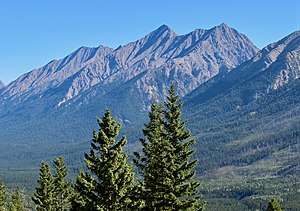Mount Harkin
Mount Harkin is a 2,979-metre (9,774-foot) mountain summit located in the Kootenay River Valley along the eastern border of Kootenay National Park. Park visitors can see the peak from Highway 93, also known as the Banff–Windermere Highway. It is part of the Mitchell Range, which is a sub-range of the Canadian Rockies of British Columbia, Canada. Its nearest higher peak is Mount Assiniboine, 14.0 km (8.7 mi) to the northeast.[1]
| Mount Harkin | |
|---|---|
 Mount Harkin seen from Kootenay Valley Overlook along Highway 93 | |
| Highest point | |
| Elevation | 2,979 m (9,774 ft) [1] |
| Prominence | 774 m (2,539 ft) [1] |
| Parent peak | Mount Assiniboine (3618 m)[1] |
| Coordinates | 50°47′49″N 115°51′52″W [2] |
| Geography | |
 Mount Harkin Location of Mount Harkin in British Columbia  Mount Harkin Mount Harkin (Canada) | |
| Location | Kootenay National Park British Columbia, Canada |
| Parent range | Mitchell Range Canadian Rockies |
| Topo map | NTS 82J13 |
| Geology | |
| Age of rock | Cambrian[3] |
| Type of rock | Ottertail Limestone[3] |
History
The mountain was named in 1923 by Morrison P. Bridgland in honor of James Bernard Harkin (1875-1955), who was Canada's first National Parks commissioner from 1911 until 1936.[4] Harkin established 11 new national parks and has been called the "Father of the National Parks of Canada."[5] The mountain's name was officially adopted in 1924 by the Geographical Names Board of Canada.[2] Bridgland (1878-1948) was a Dominion Land Surveyor who named many peaks in the Canadian Rockies.[6]
Geology
Mount Harkin is composed principally of Ottertail limestone, a sedimentary rock laid down during the Precambrian to Cambrian periods and pushed east and over the top of younger rock during the Laramide orogeny.[7]
Climate
Based on the Köppen climate classification, Mount Harkin is located in a subarctic climate with cold, snowy winters, and mild summers.[8] Temperatures can drop below −20 °C with wind chill factors below −30 °C. Precipitation runoff from the mountain drains east into tributaries of the Cross River, or directly west to the Kootenay River.
References
- "Mount Harkin". Bivouac.com. Retrieved 2019-03-18.
- "Mount Harkin". Geographical Names Data Base. Natural Resources Canada. Retrieved 2019-03-18.
- Parks Canada
- Mount Harkin PeakFinder
- BC Geographical Names
- Mapper of Mountains M.P. Bridgland in the Canadian Rockies 1902-1930, Author I.S. MacLaren, The University of Alberta Press, ISBN 0-88864-456-6
- Gadd, Ben (2008). "Geology of the Rocky Mountains and Columbias". Cite journal requires
|journal=(help) - Peel, M. C.; Finlayson, B. L. & McMahon, T. A. (2007). "Updated world map of the Köppen−Geiger climate classification". Hydrol. Earth Syst. Sci. 11: 1633–1644. ISSN 1027-5606.
External links
- Mount Harkin weather forecast
- Parks Canada web site: Kootenay National Park